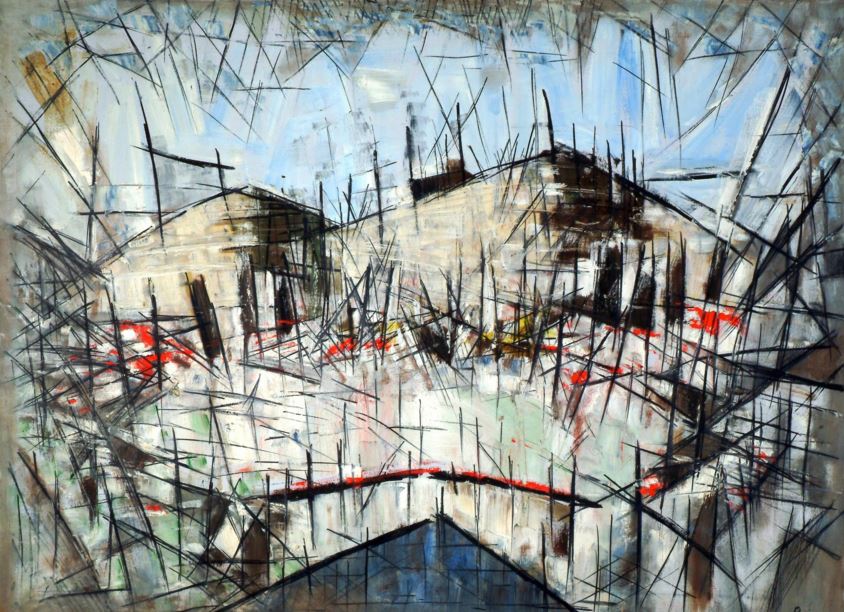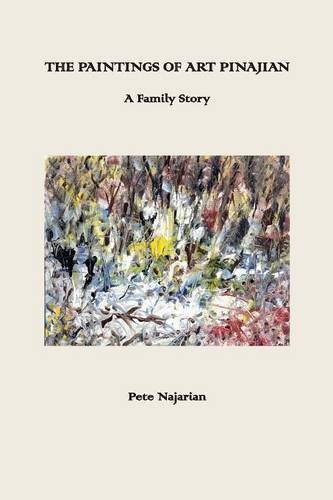Book Review: ‘The Paintings of Art Pinajian: A Family Story’
February 3, 2016The Paintings of Art Pinajian: A Family Story
By Peter Najarian
Regent Press, Berkley, California (July 1, 2015); 228 pages
ISBN 978-1587903212; Paperback $20.00
In March 2013, the New York Times, the Telegraph, and dozens of other websites and news shows reported that a trove of art, valued at $30 million, by a previously unknown painter, had been discovered abandoned in a Long Island house and garage. The artist’s name was Archie Pinajian, and though he’d sold hardly anything during his lifetime, there he was, in death, like Van Gogh, getting his comeuppance.
It was an archetypal story, rehearsed in the minds of tens of thousands of artist likewise heroically laboring in obscurity, and in this particular telling of the story—in this day and age—one can imagine hundreds of widows and widowers of these unknowns brushing back the dust from those canvases and wondering when antique roadshow might chance pass their way.
According to those early news reports, Archie lived with his sister, Armen, for most of his adult life, with nothing but painting on his mind. After she died, a real estate “flipper” purchased the house and everything in it, including the art, which, to spice up the drama, the painter supposedly wanted upon his death to be destroyed. On that last assertion, nothing was further from the truth, we discover in Peter Najarian’s moving recollection of his first cousin. In fact, “I will leave them to you,” Archie says when Peter asks what will come with the art once he is gone.
They were first cousins and kindred spirits from the start, one a writer and the other a painter, though Peter would eventually become a painter too. Their friendship, and Archie’s sometimes mentorship of his much younger cousin, is told to us mostly through Archie’s letters to Peter (heavily edited, as Archie was prone to long windedness, Peter tell us).
What we discover is that Archie was born in Union City, N.J., in 1914, and raised in an immigrant world during the Depression, where there was little room for indulging in much else beyond putting the bread on the table. Still, art tugged on him early in the form of comic books and comic strips, and he did many and successfully—for Marvel, Quality, and Centaur—before he was pulled to war. When he got back, with a bronze star, he committed himself to more serious work as a “fine artist.”
Archie had almost no meaningful contact with other painters, which isn’t to say he worked in a vacuum, but still assiduously studied and absorbed what was happening around him and had a rather intricate sense of what he aimed to achieve in his art. In his letters to Peter, he regularly referred to the “Totality” of the painting, by which he meant, I think, how a canvas can be a world in itself with all the parts drawn into perfect coordination, while still bearing a relationship, if not mystical connection, to the external world to which it points.
The best of his paintings show a vibrant color pallet and a masterful balance of dynamic energies, but absent the violence and torturedness that you find in the work of his more obvious inspirations, Gorky and De Kooning. One senses it was a matter of temperament. Archie was intense, but also unusually good natured and optimistic, never, it seems, swerving into (much less steeping in) self-destruction, or especially self-pity, for laboring in “vain” for so many years. He loved the physical world, landscapes, in particular. Their movement, color, and shifting texture was something he could never abandon for the pure abandon of treating the canvas as a formless field. He liked to paint naked women, and was very good at it, perhaps because he lacked female companionship in real life.
In coming upon a story like Archie’s, we’re naturally tempted to ask, “How is it that people so talented go unrecognized for so long?” The answer mostly has to do with where they live, who they know, who they sit down for cocktails with. Naturally, to get discovered you have to have talent, or rather talents, including schmoozing. Archie had nowhere near that kind of talent, and held fast to his belief in what he was doing, searching for an audience, and relying on Peter, and a few others, to keep artistic company with along the way.
Here and there Peter puts “family” photos, images from comic strips and books that Archie illustrated, a few images of Peter’s own paintings, and at the end of the book about 20 paintings of his cousin’s paintings. The book’s chapters are titled “Art and Death,” “Art and Family,” “Art and Society,” “Art and Promotion,” etc., and these chapters chart a course through the earliest years of Archie’s life, through his nearly 50-year work in solitude, to the grim turn of events that unfolded once Archie died, including the consequences for Peter’s sense of art, identity, and family, hence the subtitle, “A Family Story.”
‘…we sense that even as Peter is narrating the fate of family he is narrating the fate of painting. He does so in a distinct voice, unlike any that I know of in American letters—so transparent and confessional, so intimate and immediate it is sometimes painful to hear, as though after being adrift for years, he had finally found land and now had your ear, and your ear alone.’
Archie lived with his sister Armen for most of his adult life. Neither, like Peter, ever married, and so their connection to each other played a large part in making a home for themselves in the world. I won’t give away the plot, if you can call it that, but suffice it to say that once Archie dies in 1999, the relationship between Pete and Armen goes south, more or less the same direction her mind flew. For years Peter had been pushing to get his cousin’s work into the public eye, without success, and now, having sorted through pile after pile of canvases to get that part of his estate in order, Armen turns mysteriously cold and reclusive and pushes Peter to the sidelines. Then she dies and Peter’s “cousins,” who inherit the estate, suddenly find Peter a kind of interloper whose infatuation with all that seemingly worthless art is getting annoying; and come to think of it, maybe it isn’t about the art but about Peter using it to weasel his way into the inheritance! Bottom line: They want him out of the way so they can get down to the business of cashing in on the house. The paintings are literally rotting in a garage when they are “discovered,” saved even. But, outside of serving as a primary source of information for the owners of that work, Peter has no stake or say. It is hard stuff to stomach. A real estate house flipper makes out with all that art? Really? Only in America, as they say.
The narrative has some shortcomings, in terms of pace and flow, but the most serious weakness of this book is that there are too many letters from Archie to Peter, and the latter relies on them too much to do the work. It might have carried our interest if we had Peter’s letters to Archie as well, but as it turns out, the letters, not always all that interesting, must stand, and often suffer, by themselves.
In Peter’s last book, The Artist and His Mother, painting and writing exist to nurture, protect, and preserve what matters most. The devotion and intimacy required to produce authentic art is also the devotion and intimacy needed to produce an authentic life, and, likewise, the fate of the two are intertwined. So, both in his last book and in this one, we sense that even as Peter is narrating the fate of family he is narrating the fate of painting. He does so in a distinct voice, unlike any that I know of in American letters—so transparent and confessional, so intimate and immediate it is sometimes painful to hear, as though after being adrift for years, he had finally found land and now had your ear, and your ear alone.
The conclusion he reaches about these matters, of the heart, and art, is haunting. The Paintings of Art Pinajian is a must read for those who want to learn about the great painter, but it is also a must read for those who, like myself, follow Peter, and look forward to what he will next add to an already exquisite body of work.
Source: Armenian Weekly
Link: Book Review: ‘The Paintings of Art Pinajian: A Family Story’

